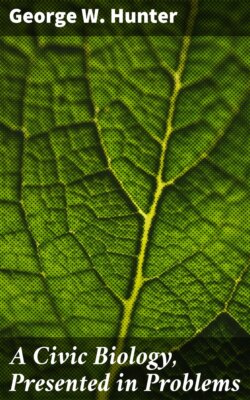A Civic Biology, Presented in Problems

Реклама. ООО «ЛитРес», ИНН: 7719571260.
Оглавление
George W. Hunter. A Civic Biology, Presented in Problems
A Civic Biology, Presented in Problems
Table of Contents
FOREWORD TO TEACHERS
A CIVIC BIOLOGY
I. THE GENERAL PROBLEM—SOME REASONS FOR THE STUDY OF BIOLOGY
II. THE ENVIRONMENT OF PLANTS AND ANIMALS
III. THE INTERRELATIONS OF PLANTS AND ANIMALS
IV. THE FUNCTIONS AND COMPOSITION OF LIVING THINGS
V. PLANT GROWTH AND NUTRITION. CAUSES OF GROWTH
VI. THE ORGANS OF NUTRITION IN PLANTS—THE SOIL AND ITS RELATION TO THE ROOTS
VII. PLANT GROWTH AND NUTRITION—PLANTS MAKE FOOD
VIII. PLANT GROWTH AND NUTRITION—THE CIRCULATION AND FINAL USES OF FOOD BY PLANTS
IX. OUR FORESTS, THEIR USES AND THE NECESSITY FOR THEIR PROTECTION
X. THE ECONOMIC RELATION OF GREEN PLANTS TO MAN
XI. PLANTS WITHOUT CHLOROPHYLL IN THEIR RELATION TO MAN
XII. THE RELATIONS OF PLANTS TO ANIMALS
XIII. SINGLE-CELLED ANIMALS CONSIDERED AS ORGANISMS
XIV. DIVISION OF LABOR. THE VARIOUS FORMS OF PLANTS AND ANIMALS
XV. THE ECONOMIC IMPORTANCE OF ANIMALS
XVI. THE FISH AND FROG, AN INTRODUCTORY STUDY OF VERTEBRATES
XVII. HEREDITY, VARIATION, PLANT AND ANIMAL BREEDING
XVIII. THE HUMAN MACHINE AND ITS NEEDS
XIX. FOODS AND DIETARIES
XX. DIGESTION AND ABSORPTION
XXI. THE BLOOD AND ITS CIRCULATION
XXII. RESPIRATION AND EXCRETION
XXIII. BODY CONTROL AND HABIT FORMATION
XXIV. MAN'S IMPROVEMENT OF HIS ENVIRONMENT
XXV. SOME GREAT NAMES IN BIOLOGY
APPENDIX
WEIGHTS, MEASURES, AND TEMPERATURES
INDEX
Отрывок из книги
George W. Hunter
Published by Good Press, 2019
.....
A wild orchid, a flower of the type from which Charles Darwin worked out his theory of cross-pollination by insects.
History of the Discoveries regarding Pollination of Flowers.—Although the ancient Greek and Roman naturalists had some vague ideas on the subject of pollination, it was not until the first part of the nineteenth century that a book appeared in which a German named Conrad Sprengel worked out the facts that the structure of certain flowers seemed to be adapted to the visits of insects. Certain facilities were offered to an insect in the way of easy foothold, sweet odor, and especially food in the shape of pollen and nectar, the latter a sweet-tasting substance manufactured by certain parts of the flower known as the nectar glands. Sprengel further discovered the fact that pollen could be and was carried by the insect visitors from the anthers of the flower to its stigma. It was not until the middle of the nineteenth century, however, that an Englishman, Charles Darwin, applied Sprengel's discoveries on the relation of insects to flowers by his investigations upon cross-pollination. The growth of the pollen on the stigma of the flower results eventually in the production of seeds, and thus new plants. Many species of flowers are self-pollinated and do not do so well in seed production if cross-pollinated, but Charles Darwin found that some flowers which were self-pollinated did not produce so many seeds, and that the plants which grew from their seeds were smaller and weaker than plants from seeds produced by cross-pollinated flowers of the same kind. He also found that plants grown from cross-pollinated seeds tended to vary more than those grown from self-pollinated seed. This has an important bearing, as we shall see later, in the production of new varieties of plants. Microscopic examination of the stigma at the time of pollination also shows that the pollen from another flower usually germinates before the pollen which has fallen from the anthers of the same flower. This latter fact alone in most cases renders it unlikely for a flower to produce seeds by its own pollen. Darwin worked for years on the pollination of many insect-visited flowers, and discovered in almost every case that showy, sweet-scented, or otherwise attractive flowers were adapted or fitted to be cross-pollinated by insects. He also found that, in the case of flowers that were inconspicuous in appearance, often a compensation appeared in the odor which rendered them attractive to certain insects. The so-called carrion flowers, pollinated by flies, are examples, the odor in this case being like decayed flesh. Other flowers open at night, are white, and provided with a powerful scent. Thus they attract night-flying moths and other insects.
.....